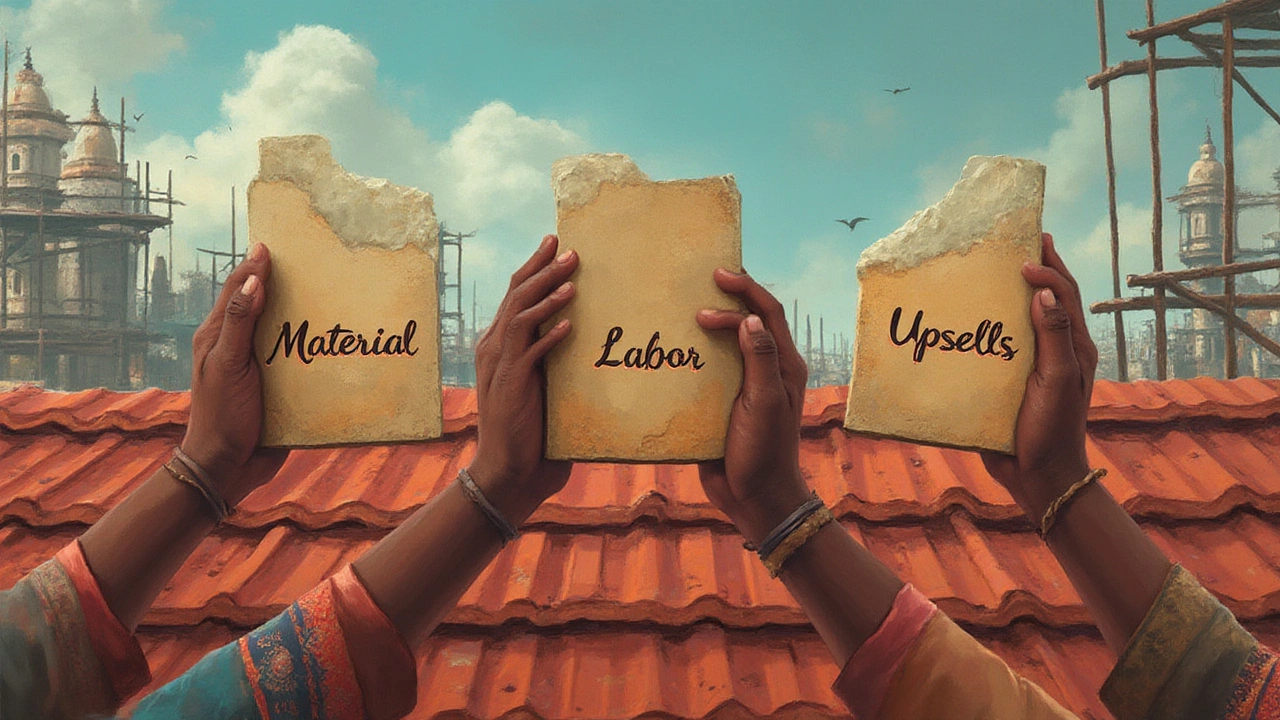Ever wonder why your neighbor’s new roof sounds cheap, but yours comes in with a price tag that feels like a punch to the gut? Here’s the reality: the answer to “What do most roofers charge per square?” will change depending on where you live, when you ask, and even which side of the street your house sits on. Trust me, there’s no one-size-fits-all, and anyone who tells you otherwise probably wants your signature on a dotted line.
Understanding Roofing Charges Per Square
Let’s cut through the industry talk. When roofers say “per square,” they literally mean 100 square feet of roofing—picture a 10x10 foot patch. Why not just price by the square foot? Old habits die hard. The “per square” pricing goes way back to when materials were measured and delivered in bulk. Fast forward to 2025, and this lingo is still hanging around like your granddad’s favorite hat.
So what’s the going rate across the US this year? On average, you’ll see numbers from $350 to $950 per square for basic asphalt shingles. Yep, that’s a massive range. Let’s make it real—say you’ve got a 2,400 square foot roof. That’s 24 squares. Low-end, you’re staring at $8,400. High end? $22,800. It’s a spread that makes you want to double-check your calculator.
The national average, according to the North American Roofing Contractors Association, has crept up to just under $600 per square as of spring 2025. This includes both labor and materials, but isn’t set in stone. California tops the chart, thanks to high wages and strict code requirements. The Midwest often comes in on the lower end, but even within a city block, company rates can differ like night and day.
Want to go fancier? Architectural shingles, metal roofs, or tile jobs start at $800 per square and climb past $1,800. High-end custom material can push things north of $2,500 a square. And then there’s underlayment, flashing, ridge vents, and sometimes a bunch of disposal fees bundled in. If you ever get a quote that feels suspiciously cheap, ask exactly what’s in—and what’s missing.
Labor eats up about 60% of most jobs. Don’t picture roofers as gold miners—they’re not getting rich, but insurance, safety gear, and experienced crews cost money. And those fees climbed higher during the last three years of material shortages and rising worker comp requirements in many states.
If you’re stuck comparing quotes, here’s a trick: request the “per square” rate broken up by materials and labor, and ask for details on each. Some companies pad their estimates with permit fees, but the municipality often charges far less than what’s shown on the bill. Always check.
Now, why might your roof cost more than your neighbor’s? Steepness matters. If your home has peaks and dormers like a gingerbread house, pro crews add what’s known as a “complexity charge,” usually an extra $100–$200 per square. Accessibility’s another nasty culprit—crowded yards, tree cover, and no clear drop-off area for the dumpster? Watch that number climb.
Watch out for two things: tear-off and layers. If you have multiple old roofing layers to remove, expect an extra $80–$150 per square for removal and disposal. “Layover” jobs—where new shingles get slapped right on the old ones—are legal in some places but messier, lower quality, and often void your warranty. Always ask what’s included.
Material prices zigzag all year long. Shingle prices jumped nearly 9% last fall, only to drop a hair in early 2025 when oil prices softened. Metal roofing prices, however, stuck around at a steady high, mainly thanks to demand for hurricane-proof upgrades in the southeast. Got a flat roof? Those cost a bit less—$350–$700 per square for single-ply membrane systems—and carry different maintenance headaches.
Roofers charge per square because it gives them a clear and standardized way to compare jobs, but for you, the devil’s in the details. Pay close attention to those “extras” like ice-and-water shield underlayment, ridge caps, and ventilation—these all tilt the number upward but make a huge difference in life expectancy.
Here’s a real-world quote from Steve Berry, owner of a top-rated roofing crew in Nashville:
"Ninety percent of complaints I see from homeowners are about jobs where the cheapest bid won. What you want is a crew that explains your options, breaks down every line item, and shows their insurance, not just a scribbled number."
With that in mind, always ask if your quote includes: old roof removal, full underlayment replacement, flashing, permits, dump fees, warranty details, and post-job cleanup. The best pros happily pull back the curtain—no hedging, no drama.
If you’re chasing savings, schedule your roof just after busy season (mid-autumn). Spring and late fall tend to see a surge in rates, since everyone’s scrambling before or after winter. Some pros even offer 5–10% off for flexible scheduling during slow periods.
Think about insurance, too. In hail zones or hurricane-ridden coasts, insurance companies sometimes have a say in both what materials you use and who you hire. Don’t let your carrier dictate everything—get two or three independent quotes before you file a claim. Once word gets out about a storm, fly-by-night roofers swarm neighborhoods with lowball offers. If the price looks too good for your area—like $200 per square—it’s either uninsured labor or materials that won’t pass a two-year test.

Factors That Affect Roofing Costs in 2025
If you’re thinking, “How can prices change so much between two suburban roofs?”, you’re not alone. Here’s the fullest picture of what drives that bill up and down in 2025, so you can spot a fair deal—or a rip-off—in your own neighborhood.
- Material choice: The biggest variation. Asphalt shingles are your budget play, but prices go up quick with metal, slate, or tile. Each material has a ‘system’ price, so always compare apples to apples.
- Roof pitch and shape: The steeper or more complicated the roof, the more time and risk. Some steep roofs need special harnesses or scaffolding, adding hours of setup before anyone can even lay a shingle.
- Removal of old layers: Most cities require a tear-off, especially if you’ve already got two layers. Dump fees for construction debris aren’t getting any cheaper, either.
- Flashing and accessories: Sometimes quotes skip over the bits no one sees right away—like flashing around chimneys, valleys, and skylights. Cutting corners here can lead to leaks, so get these listed in your estimate.
- Local building codes: Building inspectors have gotten stricter. Some towns require ice barriers or extra wind protection, which tack on $30–$60 per square.
- Labor supply and demand: In regions short on skilled labor, rates spike during busy times of year. Big city rates are always higher thanks to costs like liability insurance and specialized equipment.
- Warranty and company reputation: Contractors with solid reputations (and real insurance!) cost more upfront, but you’re less likely to chase them if something goes wrong two winters down the road.
- Hidden extras: Watch out for attic ventilation, plywood repairs, and gutter work. Reputable roofers will check your attic and decking before quoting—if they don’t, expect pricey “surprises” after they strip your old roof.
Another thing to remember: the cost per square is usually lower for bigger roofs. Small roofers still have to cover setup and cleanup, so smaller houses pay a higher price per square. Tile and slate are especially expensive, since they’re heavier and require extra reinforcing. That’s why a Spanish-tile roof in Florida can hit $2,500 a square, while a basic shingle roof in Ohio might run $400.
Material shortage is still the name of the game. Shingle producers have had a bumpy ride lately, especially with supply chain hiccups from overseas. While supply’s steadied out compared to pandemic years, you’ll still see random local shortages and price jumps after big storms. The Metal Roofing Alliance says metal roofing sales jumped 14% last year as more folks look for long-term durability and storm-protection—but that trend keeps prices high.
If you want to get super-specific in your estimate, try roofing calculators online using your home’s dimensions, zip code, roof slope and material. These give you a ballpark, but don’t substitute for a walkable roof inspection from a licensed pro.
Homeowners trying to save sometimes look at “contractor-overstock” deals online. Careful—skimping on brand-name shingles or labor isn’t worth it if you have to pay again for redo work after the next hailstorm. You can always ask your contractor if they have leftover bundles from prior jobs, but don’t push for sketchy secondhand material.
If you get three bids and one’s unusually cheap, ask for proof of insurance and a current license. If they hedge or get defensive, move on. It’s worth noting that laborers in most open roofing crews now earn $18-$30 an hour, but overhead costs (fuel, dump fees, replacement tools, workers comp) are up nearly 17% since 2022, according to the Roofing Contractors Association.
Avoid the biggest mistake—focusing only on the bottom line number. “Cheapest” rarely wins when leaks start showing up. Instead, use those numbers as leverage to get more detailed estimates and ask for references from recent jobs in your area.

Tips to Maximize Value (and Avoid Common Roofing Scams)
Nobody wants to regret their home upgrade. Here’s where the savviest homeowners pull ahead—by knowing not just who to trust, but how to get more for their roofing dollar.
- Always ask for documentation: Before finalizing anything, ask for their business license, proof of insurance, and references. Don’t take verbal promises—get it all on paper or via email.
- Require a detailed scope of work: Get every task spelled out. If the quote just says “30 squares, installed – $18,000,” ask for the step-by-step: tear-off, underlayment, shingle type, nails or staples, ridge ventilation, flashing, dumping, and cleanup.
- Ask for brand-name materials: Make sure your quote lists shingle manufacturer, product line, and color. That way, there’s no “bait-and-switch” with unbranded or discontinued stock.
- Insist on a written warranty: Good crews will offer a labor warranty (at least 2 years, often up to 10) and register your materials warranty for you. Cheap outfits “forget.”
- Pay with a trackable method: Never fork over full payment before work starts, and avoid cash if possible. Deposits run 10-20%. Only hand over the final payment after cleanup and a walk-through.
- Check your attic: Before and after. Leaky new roofs are rare, but mistakes happen. Look for new water stains or sunlight peeking through after the job.
- Schedule smartly: Summer and spring bring the highest rates, but if you can wait until late fall, you’ll often nab a discount—especially if you mention you’re shopping multiple quotes.
The real test is whether a roofer answers your tough questions without flinching. Don’t feel intimidated—good pros know transparency is their best advertisement. If the contractor pressures you with a “limited time deal” or claims prices will double next week, walk away.
One last thing: ask neighbors for recent invoices. Nothing beats seeing an actual bill for the same roofing material and square footage just down the street. Local references are worth gold, and often tell you much more than online reviews or even the fanciest website.
So, what does it all come down to? Expect to pay $500–$950 per square in 2025 for typical asphalt shingles, but know that the right questions and a careful comparison can save you thousands and buy peace of mind for decades.

Written by Fletcher Abernathy
View all posts by: Fletcher Abernathy